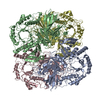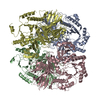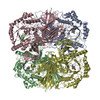+Search query
-Structure paper
| Title | Activity-based metaproteomics driven discovery and enzymological characterization of potential α-galactosidases in the mouse gut microbiome. |
|---|---|
| Journal, issue, pages | Commun Chem, Vol. 7, Issue 1, Page 184, Year 2024 |
| Publish date | Aug 16, 2024 |
 Authors Authors | Jianbing Jiang / Diana Czuchry / Yanxia Ru / Huipai Peng / Junfeng Shen / Teng Wang / Wenjuan Zhao / Weihua Chen / Sen-Fang Sui / Yaowang Li / Nan Li /  |
| PubMed Abstract | The gut microbiota offers an extensive resource of enzymes, but many remain uncharacterized. To distinguish the activities of similar annotated proteins and mine the potentially applicable ones in ...The gut microbiota offers an extensive resource of enzymes, but many remain uncharacterized. To distinguish the activities of similar annotated proteins and mine the potentially applicable ones in the microbiome, we applied an effective Activity-Based Metaproteomics (ABMP) strategy using a specific activity-based probe (ABP) to screen the entire gut microbiome for directly discovering active enzymes and their potential applications, not for exploring host-microbiome interactions. By using an activity-based cyclophellitol aziridine probe specific to α-galactosidases (AGAL), we successfully identified and characterized several gut microbiota enzymes possessing AGAL activities. Cryo-electron microscopy analysis of a newly characterized enzyme (AGLA5) revealed the covalent binding conformations between the AGAL5 active site and the cyclophellitol aziridine ABP, which could provide insights into the enzyme's catalytic mechanism. The four newly characterized AGALs have diverse potential activities, including raffinose family oligosaccharides (RFOs) hydrolysis and enzymatic blood group transformation. Collectively, we present a ABMP platform that facilitates gut microbiota AGALs discovery, biochemical activity annotations and potential industrial or biopharmaceutical applications. |
 External links External links |  Commun Chem / Commun Chem /  PubMed:39152233 / PubMed:39152233 /  PubMed Central PubMed Central |
| Methods | EM (single particle) |
| Resolution | 3.17 - 3.37 Å |
| Structure data | EMDB-36790, PDB-8k1a: EMDB-36943, PDB-8k7u: EMDB-36944, PDB-8k7v: |
| Chemicals | 
ChemComp-VQX: |
| Source |
|
 Keywords Keywords | HYDROLASE / alpha-Galactosidase / Cacl2 / inhibitor ABP2 |
 Movie
Movie Controller
Controller Structure viewers
Structure viewers About Yorodumi Papers
About Yorodumi Papers









 blautia pseudococcoides (bacteria)
blautia pseudococcoides (bacteria)